Military Regime (163 found)
Hidden Strengths, Hidden Struggles: Women’s testimonies from southeast Myanmar
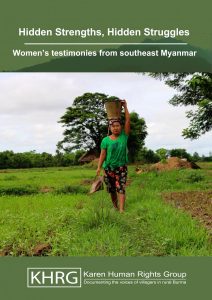 This report presents women’s testimonies in respect of various issues during the reporting period of January 2012 to March 2016. These issues include the dangers posed to women by the presence of armed actors in communities; the effects of land confiscation and development projects on women’s livelihoods; women’s access to healthcare and education; the continued occurrence of gender-based violence; and the harms caused by landmines; forced labour; arbitrary taxation and extortion […]
This report presents women’s testimonies in respect of various issues during the reporting period of January 2012 to March 2016. These issues include the dangers posed to women by the presence of armed actors in communities; the effects of land confiscation and development projects on women’s livelihoods; women’s access to healthcare and education; the continued occurrence of gender-based violence; and the harms caused by landmines; forced labour; arbitrary taxation and extortion […]
KILLING FOR COAL: arbitrary arrest, torture, and killing of villagers by Burma Army to secure Nam Ma coal mines
Burmese government troops committed serious human rights abuses, including arbitrary arrest, torture and killing of local villagers, during their offensive to drive out the Shan State Progress Party/Shan State Army (SSPP/SSA) from the coal mining area of Nam Ma, Hsipaw township, launched on May 18, 2016 […]
• • •Examining Foreign Direct Investment in Mon State, Burma
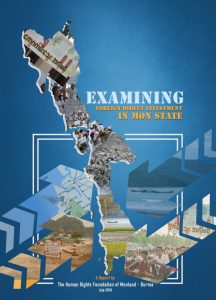 Over the years, the Human Rights Foundation of Monland (HURFOM) has produced a number of accounts highlighting the hardship faced by Mon people who have become victims to land confiscation […]
Over the years, the Human Rights Foundation of Monland (HURFOM) has produced a number of accounts highlighting the hardship faced by Mon people who have become victims to land confiscation […]
Burma/Myanmar: Geneva Call urges an end to mine use in northern Shan State
To date in 2016, 14 such incidents have already resulted in 12 civilian deaths and 29 injuries. By comparison, in all of 2015, 8 documented incidents led to 4 deaths and 18 injuries […]
• • •Burma Army must be held accountable for extrajudicial killing of seven villagers in Mong Yaw
On June 25, 2016 about 100 Burmese troops from Light Infantry Battalion (LIB) 362 arrived at the village of Mong Yang (about 10 kms west of Mong Yaw) from the Namjalarp-Loi Tao area (in the north). From Mong Yang, the troops walked in a line along the road east towards Mong Yaw […]
• • •War continues in Burma: 19-Year-Old Shot and Killed at Checkpoint, 22-Year-Old Killed by a Landmine, and a Mother injured by Shrapnel
The Burma Army is currently engaged in an escalating conflict in both northern Shan and Kachin states. The situation has left several dead, including a 22-year-old man killed by a landmine, and others injured, such as a 39-year-old mother wounded by shrapnel and incapacitated. To further highlight the lack of security the Burma Army brings to the entire region, in Myitkyina, where there is not active fighting, Burma Army soldiers gunned down a 21-year-old student at a checkpoint […]
• • •Achieving Health Equity in Contested Areas of Southeast Myanmar
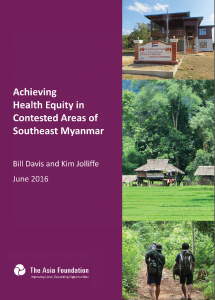 Throughout decades of ethnic armed conflict, the governance environment in many of Myanmar’s non- Burman areas has become deeply fractured, as ethnic armed organizations (EAOs) have established parallel governance systems, including healthcare departments. This report gives an overview of the parallel Ministry of Health (MoH) and EAO-linked health systems that exist in southeast Myanmar, and looks at how coordination and cooperation have increased since ceasefires were signed in 2011 and 2012 […]
Throughout decades of ethnic armed conflict, the governance environment in many of Myanmar’s non- Burman areas has become deeply fractured, as ethnic armed organizations (EAOs) have established parallel governance systems, including healthcare departments. This report gives an overview of the parallel Ministry of Health (MoH) and EAO-linked health systems that exist in southeast Myanmar, and looks at how coordination and cooperation have increased since ceasefires were signed in 2011 and 2012 […]
Myanmar CSO Shadow Report on Thematic Issues: Violence against Women
This CEDAW Shadow Report is written by CEDAW Action Myanmar (CAM). This working group is established in 2012 and consists of 15 local organizations. The report consists of perceptions of 309 (with 226 women and 83 men) respondents who participated in a survey; along with news from print and social media […]
• • •Our Customary Lands
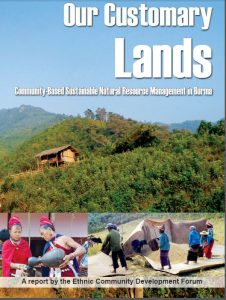 In January 2016 the government adopted a National Land Use Policy, which included the recognition of customary land management practices. While this is a welcome fi rst step in the necessary integration of Burma’s customary land management systems with the national-level system, there is an urgent need for constitutional reform and devolution of land management powers prior to any such integration […]
In January 2016 the government adopted a National Land Use Policy, which included the recognition of customary land management practices. While this is a welcome fi rst step in the necessary integration of Burma’s customary land management systems with the national-level system, there is an urgent need for constitutional reform and devolution of land management powers prior to any such integration […]
2016 Trafficking in Persons Report – BURMA: Tier 3
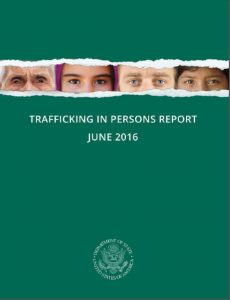 Burma is a source country for men, women, and children subjected to forced labor and for women and children subjected to sex trafficking, both in Burma and abroad. Some Burmese men, women, and children who migrate for work abroad—particularly to Thailand and China, as well as other countries in Asia, the Middle East, and the United States—are subjected to forced labor or sex trafficking […]
Burma is a source country for men, women, and children subjected to forced labor and for women and children subjected to sex trafficking, both in Burma and abroad. Some Burmese men, women, and children who migrate for work abroad—particularly to Thailand and China, as well as other countries in Asia, the Middle East, and the United States—are subjected to forced labor or sex trafficking […]

 All posts
All posts